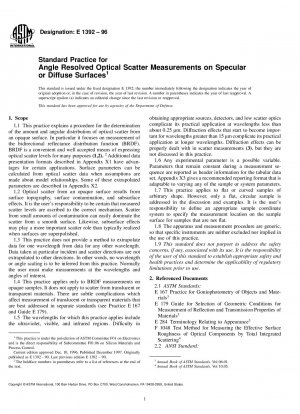ASTM E1392-96
Standard Practice for Angle Resolved Optical Scatter Measurements on Specular or Diffuse Surfaces
- Standard No.
- ASTM E1392-96
- Release Date
- 1996
- Published By
- American Society for Testing and Materials (ASTM)
- Status
- Replace By
- ASTM E1392-96(2002)
- Latest
- ASTM E1392-96(2002)
- Scope
1.1 This practice explains a procedure for the determination of the amount and angular distribution of optical scatter from an opaque surface. In particular it focuses on measurement of the bidirectional reflectance distribution function (BRDF). BRDF is a convenient and well accepted means of expressing optical scatter levels for many purposes (1,2). Additional data presentation formats described in Appendix
X1 have advantages for certain applications. Surface parameters can be calculated from optical scatter data when assumptions are made about model relationships. Some of these extrapolated parameters are described in Appendix X2.1.2 Optical scatter from an opaque surface results from surface topography, surface contamination, and subsurface effects. It is the user's responsibility to be certain that measured scatter levels are ascribed to the correct mechanism. Scatter from small amounts of contamination can easily dominate the scatter from a smooth surface. Likewise, subsurface effects may play a more important scatter role than typically realized when surfaces are superpolished.
1.3 This practice does not provide a method to extrapolate from data for one wavelength to data for any other wavelength. Data taken at particular incident and scatter directions are not extrapolated to other directions. In other words, no wavelength or angle scaling is to be inferred from this practice. Normally the user must make measurements at the wavelengths and angles of interest.
1.4 This practice applies only to BRDF measurements on opaque samples. It does not apply to scatter from translucent or transparent materials. There are subtle complications which affect measurement of translucent or transparent materials that are best addressed in separate standards (see Practice
E167 and Guide E179).1.5 The wavelengths for which this practice applies include the ultraviolet, visible, and infrared regions. Difficulty in obtaining appropriate sources, detectors, and low scatter optics complicate its practical application at wavelengths less than about 0.25 [mu]m. Diffraction effects that start to become important for wavelengths greater than 15 [mu]m complicate its practical application at longer wavelengths. Diffraction effects can be properly dealt with in scatter measurements (3), but they are not discussed in this practice.
1.6 Any experimental parameter is a possible variable. Parameters that remain constant during a measurement sequence are reported as header information for the tabular data set. Appendix
X3 gives a recommended reporting format that is adaptable to varying any of the sample or system parameters.1.7 This practice applies to flat or curved samples of arbitrary shape. However, only a flat, circular sample is addressed in the discussion and examples. It is the user's responsibility to define an appropriate sample coordinate system to specify the measurement location on the sample surface for samples that are not flat.
1.8 The apparatus and measurement procedure are generic, so that specific instruments are neither excluded nor implied in the use of this practice.
1.9 This standard does not purport to address the safety concerns if any, associated with its use. It is the responsibility of the user of this standard to establish appropriate safety and health practices and determine the applicability of regulatory limitations prior to use.
ASTM E1392-96 Referenced Document
- ASTM E167 Standard Practice for Goniophotometry of Objects and Materials (Withdrawn 2005)*, 2017-08-17 Update
- ASTM E179 Standard Guide for Selection of Geometric Conditions for Measurement of Reflection and Transmission Properties of Materials
- ASTM E284 Standard Terminology of Appearance*, 1999-04-19 Update
- ASTM F1048
ASTM E1392-96 history
- 1970 ASTM E1392-96(2002)
- 1996 ASTM E1392-96 Standard Practice for Angle Resolved Optical Scatter Measurements on Specular or Diffuse Surfaces
